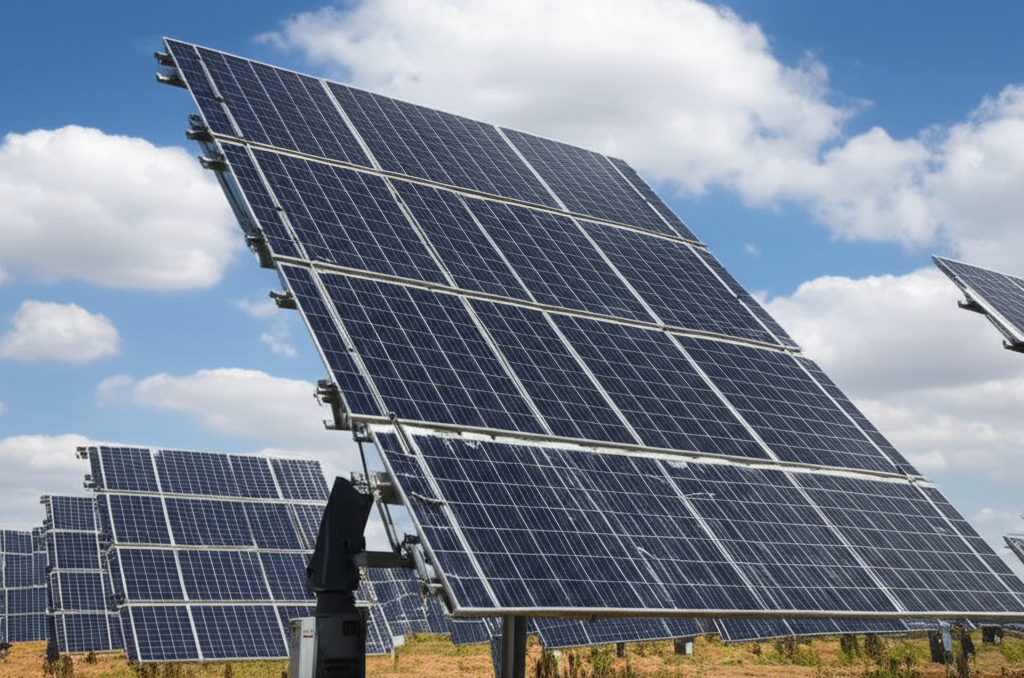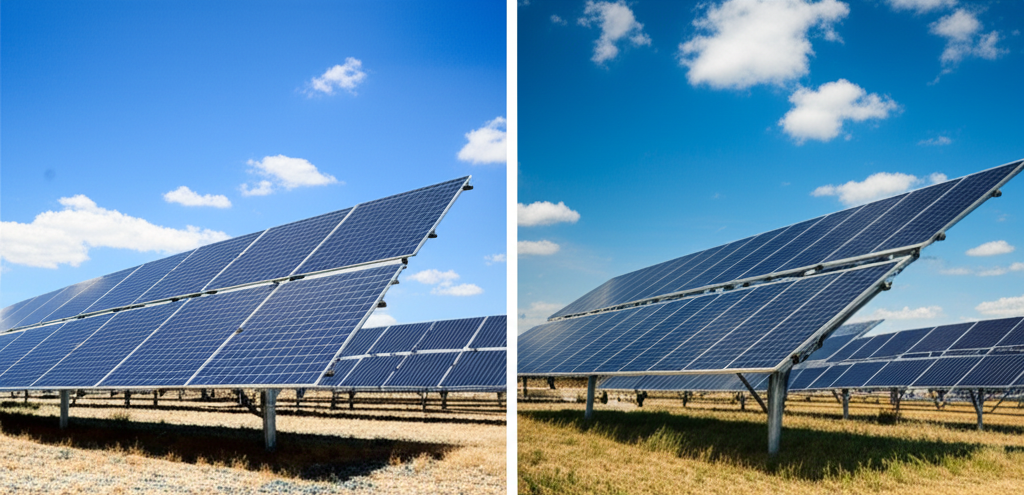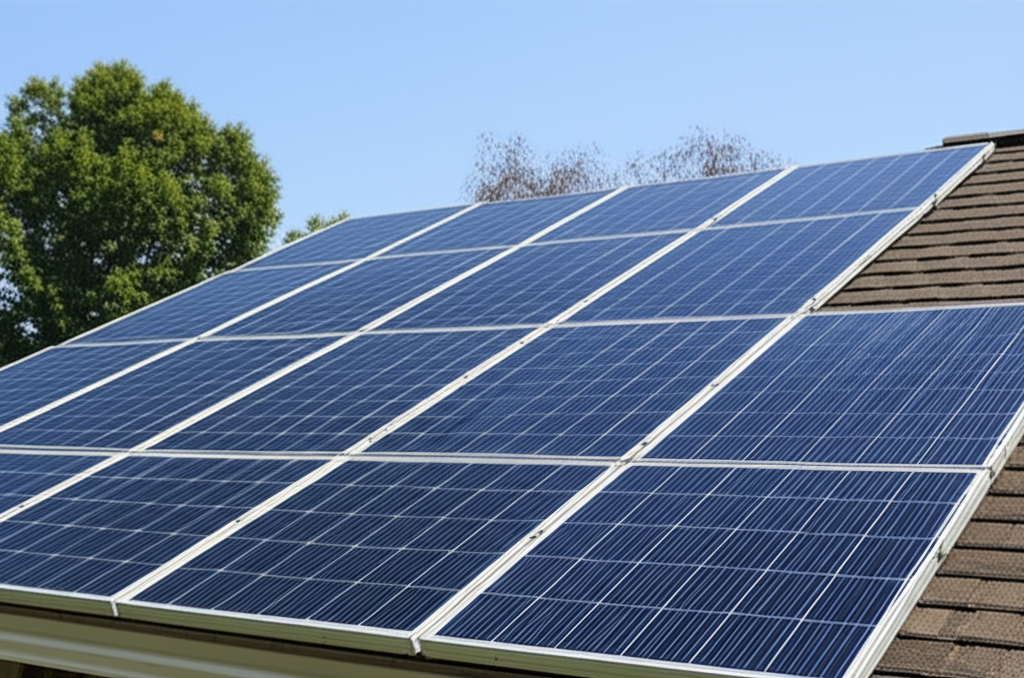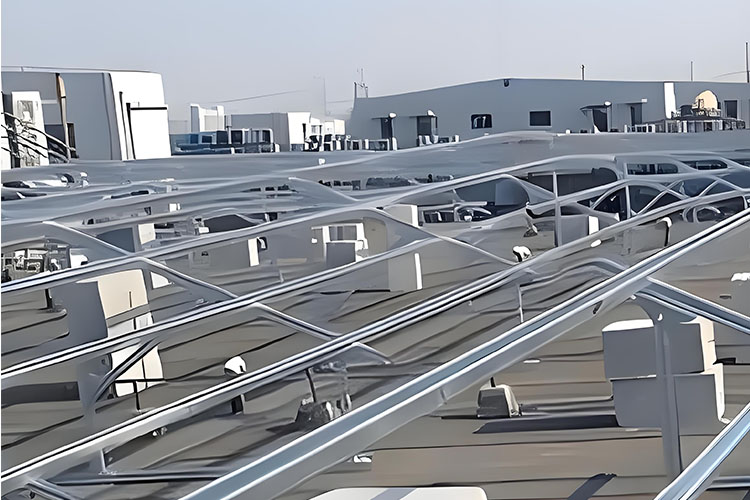あなたは、太陽光発電施設から予測可能な収益を得たいと考えている。また、O&Mにおける不満も減らしたい。トラッカーは、もう1つ移動する部品のように見えるかもしれない。危険だと感じることもある。しかし、これが真実です。最新の追尾式は、適切なシステムを選択し、自制心を持って運転すれば、エネルギー収量を上げ、LCOEを削減し、生涯O&Mを削減します。.
ソーラー・トラッキングを理解する:その仕組みと重要性
太陽追尾システムは、一日を通してPVコンポーネントを太陽に向ける。単軸トラッカーは1つの軸で回転する。二軸トラッカーは方位角と高度を追尾する。コントローラーは、天文計算式とセンシングユニットのコメントを利用して、最適な放射照度になるようにコンポーネントを配置する。優れた追尾性により、シェーディングを軽減し、拡散光の捕捉を強化し、暴風雨の中で様々なものを保護するために風の収納に気を配ります。.

このことは、リターンにどのような意味を持つのだろうか?独立した調査研究によると、単軸トラッカーは通常、修理されたチルトよりも約15~25%エネルギーを増加させます。二軸システムは、緯度やレイアウトにもよるが、25 - 35%に達することができる。トラッカーと二面体コンポーネントを組み合わせれば、適切な地面のアルベドにより、裏面利得からさらに5 - 15%を得ることができる。
金武宣輝科技有限公司のSolPathは、スマート・トラッキング・システムを設計し、これらの利益を手の届くところに置いている。列間シェーディングを低減する耐陰性トラッキングが得られる。リモート・コミッショニングとOTA(over-the-air)アップグレードにより、ソフト価格を削減。コントローラー、アクチュエーター、配置を単一のサプライチェーンで提供することで、納期を短縮し、複雑さを軽減します。.
神話1:“トラッカーはROIを正当化するために価格も高い”
資本的支出は本当に恐ろしく感じる。あなたは投資回収を尊重する。しかし、ROIは生涯エネルギー収穫量と所有にかかる総費用にかかっている。.
- 1軸トラッキングは、15~25%の電力を含むが、数カ所のチルトに対応 - 2軸トラッキングは、最良の問題で25~35%を供給 - 最適化されたトラッキングは、ユーティリティ規模のプロジェクトでLCOEを約5~10%削減
この結果はどこで判明するのか?DNIの高い中緯度。風力と地質学的に有利なウェブサイト。PPA条件やマーチャント市場を通じて、追加kWhごとに収入が得られるような事業。トラッカーの二面体コンポーネントは、より強力なビジネス経済性のために裏面利得を向上させることができる。
ROIスナップショット固定とトラッキングの比較(図解)
| シナリオ(100MWdc) | エネルギー利得対固定 | 推定LCOE デルタ | 投資回収の目安 |
|---|---|---|---|
| 固定チルトベースライン | — | — | — |
| 単軸トラッカー | +15–25% | -5-8% | 4~7年 |
| デュアルアクシストラッカー | +25–35% | -8-10% | 5-8年 |
数字は独立した基準による市場品種を示す 最終的な数字は、あなたのサイトが決定する。.
ソルパスの価値は、スチールやモーターを凌駕する。影に強いアルゴリズムはミスマッチの損失を減らします。リモート任命は、マウント時間をトリミングします。OTAアップデートは、トラックロールなしでフリート全体の効率改善をロールバックすることを可能にします。この組み合わせは、リターンを増加させ、返済を減らすソフト費用を削減します。.
実行可能なステップ

- その場所固有のTMYデータで歩留まりをモデル化し、二刀流のリアサイドの仮定を含める。.
- 賢明なO&Mと追加戦略でLCOEを向上させる。.
- 構造および風収納設計を、近隣の法令や突風計算と照らし合わせて検証する。.
価格管理が最優先の課題であれば、ソルパスの以下のサービスをご検討ください。 Cost Effective Tracker 提示されたインプリメンテーションの代替案。.
迷信2:「トラッカーは頻繁に故障し、継続的なメンテナンスが必要だ“
古いシステムは戦った。現代の追尾装置はそうではない。市場情報によれば、今日の追尾装置の年間メンテナンス費用は、予測メンテナンスやスマート制御を使用した場合、初期投資額の1%を下回るのが一般的である。.
ソルパストラッカーは、クローズドループのコメントと天文測位を利用している。システムは強風に耐え、構造物を保護する。消雪モードとアンチシャドウ・レジメンは、厳しい気候下でのアクセシビリティを向上させる。リモート・モニタリングは、適用除外に迅速にフラグを立てる。OTAファームウェアのアップデートにより、現場での作業なしにソリューションと属性を提供します。.
O&Mプロファイル:固定対トラッキング(典型的な範囲)
| System Type | 設備投資の%としての年間O&M | メンテナンス・フォーカス |
|---|---|---|
| 固定傾斜 | ~0.5-1.0% | モジュールのクリーニングと電気 |
| 単軸 | ~0.8-1.0% | 潤滑、ドライブチェック、ファームウェア |
| デュアルアクシス | ~1.0~1.2% | ジョイントの追加検査と校正 |
品種は市場の規範を示し、ウェブサイトや技術によって異なる可能性がある。
アップタイムを高く維持する最も優れた方法:
- タイムテーブルを気にするのではなく、コンディションに応じた潤滑を行う。.
- モーター電流の傾向や配置のミスにより、摩耗を早期に把握する。.
- ウィンドストウとヒーリングシリーズを毎期検証する。.
- アクチュエータとコントローラの追加キットを標準化する。.
計画的な維持管理戦略をお望みですか?ソルパスの Installation Maintenance リストとピリオドのサポート。.

神話3:「トラッキングはほとんどエネルギーを向上させないから、固定でも問題ない“
修復された傾斜は、いくつかのサイトで十分に役立つことができる。数多くの地域で、トラッキングの勝利が強調されている。.
- 単軸:単軸:+15 - 25%のエネルギー対チルト対策 - 二軸:+25 - 35%のエネルギー対チルト対策:二軸: +25 - 35%のエネルギー対チルト対策 - 二軸+単軸: アルベドと列間隔によりさらに+5 - 15%
場所は重要だ。緯度が低く、晴れた空はトラッキングに有利です。コントローラーが拡散光に最適化できるため、拡散環境でも利益を得ることができる。優れた畝間とソルパスの耐陰性トラッキングにより、畝間のシェーディングが減少するため、早朝や日中の遅い時間に多くの収穫ができる。.
アプローチ別エネルギー利得(業界ベンチマーク)
| アプローチ | エネルギー利得対固定ティルト |
|---|---|
| 固定傾斜 | — |
| 単軸トラッキング | +15–25% |
| 二軸トラッキング | +25–35% |
| 単軸+バイフェイシャル | 合計+20-40% vs 固定(合計) |
独立した記録から集計されたデータ ウェブサイトの問題管理 最後の利益.
降伏を北極星とするなら、ソルパスの Smart Tracker 拡散光と後側方ゲインの角度を微調整する選択肢。.
神話4:「トラッカーは大規模な公共事業のためだけのものだ“
ユーティリティ・プロジェクトが採用をリードする。その通りだ。問題がフィットすれば、小規模なアプリケーションも恩恵を受けることができる。.
- 明確なスパンと建築能力を備えた商業施設の屋上。.
- 地上設置型の商業用ビハインド・ザ・メーター・サイトで、使用時間帯別料金制。.
- 午後の収穫に報いる農業および非電化システム。.
ソルパスは分散型発電や特定のニッチな用途向けに拡張性のあるスタイルを提供しています。ご覧ください Commercial Tracker あなたのウェブサイトにグランドエリアがある場合、サービス発見 Agricultural Tracker 肩車の時間帯により多くの電力を必要とする牧場での使用例。遠隔地のウェブサイトでの耐障害性については、以下をご検討ください。 Offgrid Tracker.
ウェブサイトに適しているかどうかが、選択の決め手となる。十分なトラブルがあり、日陰が少なく、適切な風力プログラムがあり、費用対効果の高い構造であることが望ましい。これらの条件を満たせば、ユーティリティ・スケール以外でもトラッキングを保証することができる。.
神話5:「トラッカーは環境に優しくなく、資源を浪費する“
トラッカーは鋼鉄と制御装置を追加する。さらに、1エーカーあたりのエネルギー量を増加させ、供給されるkWhあたりの土地占有面積を縮小する。歩留まりが上がれば、仕事のLCOEが下がる。この低下により、製造の影響がより多くの世代に分散されるため、kWhあたりのライフサイクル排出量が削減される。 二面体のコンポーネントは、余分なアクティブ・コンポーネントを使用することなく、背面収穫量を増加させる。
長寿命と長寿命を実現するSolPathレイアウト。コントローラーはOTAアップデートを取得し、機器を交換することなく能力を延長する。耐陰トラッキングは、不等間隔を最小化し、モジュールがより近い位置で動作していることを維持します。これは、数十年にわたり、より優れた電力捕捉を意味する。.
持続可能性があなたのプログラムにとって重要なら、ソルパスの Eco Friendly Tracker 製品へのアプローチとライフサイクルの推論。.
正しい太陽追尾システムの選択
オプションがROIとリスクを形成するサイトと組織のニーズから始めましょう。.
- 場所と緯度がパワーの原動力.
- 風荷重と積雪荷重は、建築のレイアウトと店舗の推論を形成する。.
- 土壌とジオテックが構造物の価格を決定する。.
- 相互接続とSCADAは同化作業を指定する。.
- 畝間とアルベド処理に影響する二面性アプローチ。.
- 緯度と空模様がリターンを有意義なものにするトラッキングを目標とする。.
- 適切な地盤問題のもとでエネルギーを追加するために、トラッカーを二面体コンポーネントと組み合わせる。.
- ウインドストーを慎重に設計し、リカバリーシリーズを検討することで、アップタイムを守る。.
- リモート・コミッショニングとOTAアップデートを利用することで、ソフト面での出費を最小限に抑え、時間の効率化を図る。.
- 予知保全と標準スペアで、O&M予算を設備投資額の1%以下にする。
- ソーラートラッカーは暗い日でも使えるのか?.
- ソーラートラッカーシステムの価格は?.
- ソーラートラッカーの寿命はどのくらいですか?.
- 既存のソーラーパネルにソーラートラッカーを追加できますか?.
- 単軸とケア付きと二軸の比較について、サイト別の歩留まりとLCOEの評価を依頼する。.
- 建築設計をロックする前に、ジオテックと風の問題を検証する。.
- コンディションベースのメンテナンスとOTAアップデートで、O&Mプログラムを初日から計画。.
- 最新のトラッカーは、ウインドストウやスノーシェッディングの設定により、悪天候でも確実に作動する。遠隔監視とOTAアップグレードは、手動介入とメンテナンスのオーバーヘッドを低減します。二軸の利得は良好な条件下で20~40%、一軸では15~30%が一般的です。ソルパスシステムは、スマートな耐陰性トラッキング、リモートアポインティング、トラッカー、コントローラー、マウントの完全なサプライチェーンカバレッジを維持します。.
クイック比較:一軸と二軸の比較
| Feature | 単軸 | デュアルアクシス |
|---|---|---|
| Yield Gain vs Fixed | +15–25% | +25–35% |
| CAPEX | より低い | より高い |
| O&Mの複雑さ | より低い | より高い |
| ベスト・フィット | 公益事業および大規模C&I | 専門サイトまたは価値の高いニッチ |
| 両面シナジー | 強い | 強い |
SolPathはエンド・ツー・エンドの配信を維持します。トラッカー、コントローラー、設置が1つのプログラムで提供されます。ソリューションは一般的なPVモジュールとインバーターに対応しています。コントローラーは遠隔試運転とOTAアップグレードが可能で、労力と通電速度を削減します。規模については Utility Scale Tracker の救済策です。コンポーネントレベルの選択については Tracker Components.
実践的な教訓
そうだ。コントローラーは散乱光を配置するために高価なアルゴリズムを使用しています。それでも、レンジが放射照度を広げるために最適な角度を保つという事実のために利益を得ることができます。.
コストは場所や構造の選択によって異なる。単軸は通常、補修用チルトに比べ設備投資額は小さいが、エネルギーを15~25%向上させ、ユーティリティの範囲ではLCOEを5~8%低下させることが多い。
レイアウトの寿命は、PVモジュールの寿命と一致することが多く、20~25年のアレイが多い。アクチュエーターとコントローラーは、取り決められた交換サイクルに従います。予知保全により、ソリューション間隔を延長し、ダウンタイムを削減します。
構造およびクリアランスが許せば、地上設置型サイトにも後付けできる。共通のユーザー・インターフェースを利用すれば、既存のインバータやSCADAとの統合も簡単です。サイト分析により、実現可能性と費用を検証します。.

次のステップ
トラッキングによって数字がどのように変化するかを確認する準備は万端だ。.
ソルパスの Utility Scale Tracker スケジュールをご確認ください。あるいは、私たちの Cost Effective Tracker. .スムーズなインストールとライフタイム費用の削減が必要な場合は、次のことを検討してください。 Installation Maintenance.
参考文献
グランドビューリサーチソーラートラッカーの市場規模、シェア、動向分析レポート。2024年1月。.
フラウンホーファーISEPVモジュールとシステムの既存および将来の性能。2024年1月.
ブルームバーグNEF2023年の平準化電気料金。.
ウッド・マッケンジー太陽光発電トラッカーの世界市場シェアと出荷額 H1 2023.
NREL追尾式二面体PV:エネルギー収量の向上。2023年4月。.
検証ノート.